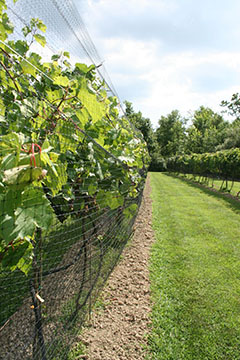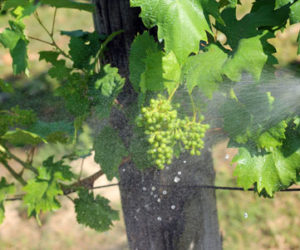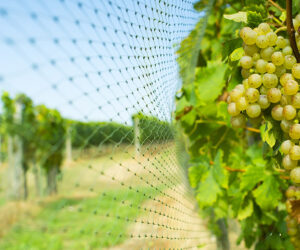
Grapevines are the world’s greatest natural birdfeeder. Grapevines have adapted for millions of years on this planet to accomplish one end: Produce ripe berries to attract birds. The birds eat the berries, fly to a different part of the forest and relieve themselves — dropping the seed in a nice little dollop of moist fertilizer to germinate a baby grapevine. Even the shape of a mature grapevine lends ease to bird feeding. Last year’s growth becomes a perch, and the fruit that emerges is always at the first few nodes — right at beak level.
Keeping birds from eating any of your backyard grapes is not easy, but there are plenty of devices and exclusion devices (nets) that can keep your crop all but pristine.
When birds attack
Grapes have a built-in attractant for birds. Sure the grapes are delicious and sweet, sure they can ferment and attract animals with the promise of intoxication, but the secret weapon of the grape for attracting birds and other hungry animals is color change. When a green berry changes color and turns dark and purple, that is an indication to birds that it’s time to feast. This is not a mistake! The moment the berries soften and change color (to either red/purple or golden) is indicative of the seed of the grape berry reaching maturity. At the exact moment of veraison the seed is viable to go through the gut of an animal (or fall to the ground) and germinate into a new vine.
Developing an Integrated Pest Management (IPM) program is important to the home vineyard. The first responsibility in making a plan to combat pests is determining which pests are present. To that end let’s take a look at some common patterns and bird species so we can define our enemies in the vineyard.
Patterns of bird feeding
• Large flocks of birds scare easier than small flocks.
• Bird damage patterns are highly localized and difficult to predict.
• Once birds return to a vineyard fora few years, breaking their feeding habit is nearly impossible as long as a single bird in the flock lives from season to season.
• Crops near trees, fences, power lines and nesting areas, as well as those areas with available drinking water will be hit the hardest by birds.
• Birds will only be fooled a few times by non-damaging noise makers, owl ‘kites’, flash tape and the like. These devices may help to encourage the flock to hit another vineyard with less scare devices, but don’t expect these methods to save your crop.
• Birds are easily diverted to other feeding areas by predator pressure and real or perceived danger.
• Birds don’t give up easily on food.
• Birds usually fall back to feeding patterns from previous years.
• Birds feed early in the morning, late in the evening and at sunset. (Crepuscular)
• Birds prefer areas where they can drink water and eat your fruit.
• Vineyards next to a forest can be extra attractive to birds.
• The more fruit birds find in your vineyard, the more birds will follow them in each time.
• Early ripening grapes (Pinot Noir, for example) are very attractive to birds.
• White grapes are largely ignored when red grapes are ripe and available. Always net red grapes first.
Birds you don’t want to see
Starlings/Grackles/Blackbirds (very damaging): This class of birds is the most destructive to your crop for a number of reasons. First, starlings are the most destructive agricultural pest in the United States. They travel in massive flocks and can take multiple berries into their mouths, fly away and eat them at their leisure. I have personally seen flocks of thousands of birds that can devastate an acre of Pinot Noir in a very short time. Starlings are not native to the US, and were brought over to
this country in 1890 as part of a campaign of introducing new animals to the US for varying reasons by the American Acclimatization Society. One hundred European Starlings were released in New York’s Central Park (part of a program to add any birds to Central Park that appeared in a work by William Shakespeare), and that flock has reproduced into hundreds of millions of grape-starved pests.
Grackles and blackbirds are similarly grape-hungry, but generally travel in smaller packs even though they can be just as damaging on a bird-to-bird basis. Grackles and blackbirds will also flock with starlings, and generally follow similar distribution, feeding and biological habits. These birds are hungry, smart and driven to capture your fruit. In the past 20 years I have personally seen starlings, specifically, learn to hang off vineyard bird netting with their feet and use their beaks to get through the nets and grab a few berries. I’m very worried they will eventually learn to manufacture and carry small knives and scissors to cut open the nets. Let’s hope this is just a recurring nightmare of mine.
Sparrows/Finches/Robins/Orioles and other small “chirpy” birds (somewhat damaging): I call these the “scout birds” because they let me know when the grapes in my vineyard are starting to become palatable to pests. It is easy to tell the difference between starling damage and sparrow/finch damage because starlings take whole berries generally (as illustrated in the picture on page 67) and sparrows tend to peck the fruit to taste the sugar content and consume the seed from within. If a sad looking skin remains on the cluster, that was likely sparrow damage. They tend not to flock in large groups, but instead hang out in small grape-pecking gangs that do little damage to a commercial vineyard, but can cause enough loss in a backyard vineyard to warrant netting, even if starlings and their ilk are not an issue.
Birds you do want to see
Crows/Ravens (slightly damaging, somewhat protective): Crows are very smart birds that are generally more interested in the insects in your vineyard than the grapes. I have seen them taking a little bit of fruit, but in general I believe that their territorial behavior (while in small to medium groups called murders) do a good job of scaring away larger and more damaging flocks of starlings. They commonly flock and circle behind tractors and other agricultural implements, and swoop into freshly cultivated areas to search for insects exposed by the process, as well as gophers, mice and voles stunned or killed in the process.
Birds of prey (very protective, no damage to grapes): Encouraging birds of prey in your vineyard is likely the easiest and cheapest method of guaranteeing balance and minimal bird-pest damage. Falconers are enjoying increasing employment in vineyards all over the world, where they fly raptors around a vineyard to discourage starlings and other birds from using the vineyard as a smorgasbord. Hunting perches and safe places for birds of prey to rest and observe the vineyard will certainly help in reducing bird pressure in your vineyard, but if the raptor moves on, the starlings will likely be back very quickly. As an aside, an owl box in a safe, secluded tree can produce up to 3-4 baby owls a year, and even though they aren’t bird hunters, they will devastate the populations of gophers, mice and voles in your vineyard and may even take small squirrels.
Bird netting
The best way to protect a grape cluster from a bird is by excluding the bird physically from being able to make contact with the berries. Easier said than done!
For best protection it is vital to use the most common protection of fruit — bird netting — at the first sign of fruit softening. It is common in commercial viticulture to lose a few berries to early bird predators before the nets go up. Pay close attention to the vines in your backyard, and as soon as a few berries turn pink, finish your last bit of canopy management/leaf pulling/shoot positioning and start draping and tying those nets. Perfect vertically shoot positioned trellises allow the nets to be snug against the canopy and the crop, and the birds have learned to grip the net and peck through it. As a result, I tend not to hedge the vines into a tight and uniform canopy, but instead allow the shoots/canes to flare and droop just a little so the net billows out a little and isn’t tight against the clusters where the birds can reach berries with their nasty beaks. There are a variety of ways bird netting may suit your home vineyard:
Draped over whole row and tied at the bottom: 14 feet (4.3 m) is about standard width, and the rolls come in every size up to 5,000 feet (1,524 m). Like anything, the more you buy the better the deal, so I always buy 5,000 feet (1,524 m), which covers a little less than an acre at 8-feet by 4-feet (2.4-m by 1.2-m) spacing. Getting a full roll will also allow you to replace torn netting each year. Some prefer the black plastic netting (shown in the picture on this page), and some prefer the green “cloth” type (shown on page 68). Both work well, I find the cloth nets that are stored in bags are easier to work with and don’t rip up my hands as bad. Once your vines are perfected in their fine-tuning (all leaves pulled, green crop dropped, etc.), roll the nets up at the bottom and secure them with large twist ties (we use 4-inch/10 cm size). That way the birds, squirrels, raccoons, and other pests can’t crawl up into the fruit zone.
Fruit zone netting: The new trend is netting only the fruiting zone and clipping netting onto an area about 42 inches (1 m) wide. This is cheaper and lots of folks like the ease of application, and more and more vineyards are leaving their nets on the trellis year-round, near the drip tubing/irrigation wire. Sun and weather will surely lessen the longevity of nets used in this way, but it makes storage and application much easier, and will likely pay for itself. There is anecdotal information that birds can get at the fruit a little easier than over-the-row netting that is secured on the bottom.
Canopy netting (nets over the top of the whole vineyard): The new trend near my vineyard is to use the 14-foot (4.3-m) wide nets and drape them over the entire vineyard, slightly overlapping, and closing the system to the ground with landscape staples to close the entire vineyard off from all types of pests. Certainly a coyote or a deer could break the net and get in, but I am seeing superior control with this style of netting. Although I have yet to see the application technique, it seems in the home vineyard it would be easy with 3-4 tall and strong young helpers.
Hybrid netting: Use over-the-row netting on the perimeter of your vineyard and fruit zone netting in the middle. Some vineyards have success with propane cannons in the center of the vineyard, with no nets in the middle, and perimeter netting to discourage damage at the edges, where it is often most serious.
Other control
Propane cannons: These are generally not usable in backyard vineyards because of the riot it will cause in your neighborhood. Propane cannons in rural areas work well when integrated with perimeter netting and backing up the “fake explosions” with some real shotgun blasts that kill birds in the flock.
Shotguns or air rifles: In my 20 years of winegrape farming, I have come to an understanding that killing a few birds in a flock does have a strong impact on the flock’s willingness to come back to my vineyard. Propane cannons are swiftly ignored if not integrated with real death and destruction. Flock dynamics and sociability in bird flocks is strong, and a few birds violently falling mid-flight does strongly encourage a flock to find easier hunting. In a domestic backyard, you may be able to carefully and safely use a pellet or BB rifle to cause enough damage to the pest birds to lessen pressure. To be frank, nothing works as well as a few well-placed shotgun blasts into the heart of a starling flock. Make sure to follow up the injured birds and end their suffering, as nothing deserves to die slowly — even my least favorite bird on the planet (the one eating my wine).
Bird scaring devices that imitate bird predators (owl kites, flash tape, etc.): These work well as part of a larger IPM program, but generally are ignored by birds after a few days. They may drive lazy birds to your neighbor’s backyard vineyard, but they will not protect the fruit in any permanent or meaningful way by themselves.
Feral or domestic cats: You may be surprised how a few feral cats (rescued from a local shelter or organization) will keep birds from feeling safe in your vineyard. Cats are amazing hunters and enjoy the hunt immensely. And even though they are better at keeping vole, mouse and gopher populations in check, they will hunt birds in the vineyard, and have a better chance of jumping for one that is busy with a grape cluster. Don’t expect a cat or two to end your bird pest problems, but do integrate a few cats into your backyard IPM. They need the home and they will work hard every day for a few nuggets of kibble. No papers or worker’s comp needed!
Conclusion
Bird control in the home vineyard should make use of a hybrid system specifically designed around your backyard. With limited vines and clusters, you really want to protect every berry from birds. Using wide nets and enclosing your rows in a tight system of protection is my go-to answer for small production vineyards, but using this system in combination with feral cats, encouraging birds of prey to visit your backyard, a pellet gun and a lawn chair. The key, as in all viticulture, is timing. Letting the vines sit an extra week to watch a few baseball games will guarantee the birds will get their share of your precious fruit, so as soon as you see a few pink berries and your canopy management is complete, get those nets up!






